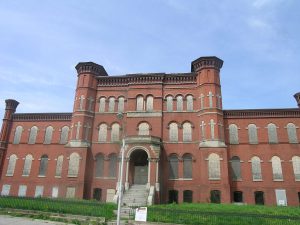A New Canvas for Baltimore: Old Hospital Gets New Life
One of the most historic buildings in Baltimore City, the Hebrew Orphan Asylum, was once known for the care provided within its walls. With Project C.O.R.E. funding, this West Baltimore landmark will again serve as a place of healing for city residents.
The Coppin Heights Community Development Corporation received $175,000 during the first round of Project C.O.R.E. funding to assist in completing its rehabilitation. When finished, the building will be the home to the Center for Health Care and Healthy Living, a full-service medical facility, without compromising its integrity as a historical site. The center will include pediatric care, pediatric dentistry, women’s health care and a pharmacy, all operated by the Baltimore City Health Department. The $12 million project received prior funding from the Maryland Department of Housing and Community Development in the form of $350,000 in Strategic Demolition funds for preparation of the construction, awarded in 2014. The building was formerly owned by Coppin State University, which sold it to the CHCDC in 2014. It has sat vacant since 1989.
The building falls within the bounds of a Health Enterprise Zone as designated by the Maryland Department of Health and Mental Hygiene, meaning it exists in an area where the state has identified a critical need for reducing health care disparities for residents. Currently, options for health care in this area of the city are very limited. To reopen under its new purpose means improved access to vital care for the people of Baltimore City.
After the Hebrew Orphan Asylum moved locations in 1923, it became the home of West Baltimore General Hospital from 1923-1945, followed by the Lutheran Hospital of Maryland from 1945-1989. Renovating this facility to provide optimal health care for city residents keeps with the building’s history. The building was also listed on the U.S. National Register of Historic Places in 2010. As the city’s revitalization continues, preserving this important piece of living history will help foster a healthier Baltimore.
“A New Canvas for Baltimore” is a regular series covering Project C.O.R.E. (Creating Opportunities for Renewal and Enterprise). Project C.O.R.E. will clear the way for new green space, new affordable and mixed use housing, and new opportunities for small business owners in Baltimore City. The initiative will generate jobs, strengthen the partnership between the City of Baltimore and the State of Maryland and lead to safer, healthier and more attractive communities. For more information on Project C.O.R.E., visit http://dhcd.maryland.gov/ProjectCORE/.

